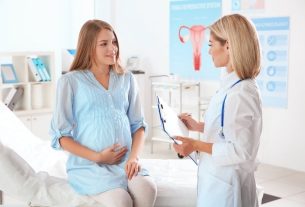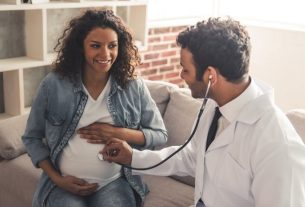In the 27th week of pregnancy, the baby’s development is marked by being able to open their eyes and having more regular phases of sleep and wakefulness, with rapid eye movements (REM) during sleep, which are important for processing memories.
Additionally, the lungs continue to mature and the baby may experience hiccups due to the breathing movements that help prepare the lungs for breathing after birth.
During this week, the woman may continue to have symptoms of cramps, swelling in the legs or feet, or Braxton-Hicks contractions, and hemorrhoids may appear.

Baby development
In the 27th week of pregnancy, the main milestones in the baby’s development are:
- The baby’s brain is more active and neurons continue to form, making complex connections in all areas of the brain;
- The eyelids are no longer fused, which allows the baby to open their eyes;
- The baby now has more regular phases of sleep and wakefulness and when he sleeps, he already has rapid eye movements (REM), which is the phase of sleep that is important in processing memories.
The lungs continue to mature, the alveoli, which are small air sacs in the lungs, begin to expand and the baby may experience hiccups, but they do not make any noise because there is no air in the lungs.
These breathing movements are important to prepare the baby’s lungs for breathing after birth and some women may feel the fetal hiccups lasting a few seconds or minutes.
Baby size and weight
The size of a baby at 27 weeks of gestation is around 35 centimeters, measured from head to toe, and around 24.4 centimeters from head to bottom, equivalent to the size of a turnip.
The baby’s weight this week is around 1.0 kg.
Changes in a woman’s body
In the 27th week of pregnancy, the breasts are already larger and the belly continues to increase in size, which can cause back pain or swelling in the legs and feet, due to the weight of the uterus, which can compress the veins and arteries in the region. pelvic, making circulation and return of blood from the feet and legs to the heart difficult.
At this stage of pregnancy, symptoms of leg cramps or Braxton-Hicks contractions may continue.
Furthermore, it is common to develop hemorrhoids due to the dilation of blood vessels in the anal region, due to the compression of these vessels by the weight of the uterus and also due to hormonal changes during pregnancy that can slow down the intestines, causing constipation that leads to straining. greater for defecation and the dilation of blood vessels.
Care during the 27th week
In the 27th week of pregnancy, some precautions are important to help alleviate discomfort that may arise, such as:
- Back pain: do not stand for a long time, avoid crossing your legs when sitting, use a pregnancy belt to support your belly and back, or apply hot compresses to your back. In addition, you should practice physical activities recommended by your doctor, such as stretching, yoga or Pilates to strengthen the muscles of your back and pelvis; Check out the best exercises to do during pregnancy;
- Swelling in the legs or feet: place your feet higher than your body, with the help of a bench or cushions, when sitting or lying down, do not wear tight shoes, do not stand for a long time and practice regular physical exercise, such as walking or swimming, as advised by your doctor, can help reduce this discomfort. However, if the swelling does not improve, starts suddenly, or has swelling in the hands and face, you should seek medical help immediately, as it could be a sign of pre-eclampsia. Find out more about pre-eclampsia and how it is treated;
- Leg cramps: massage or gently stretch the calf, making movements with the feet, pulling the heel down and the toes up, or applying hot compresses to the cramping area, such as the feet, ankles or legs. Additionally, you can increase your consumption of foods rich in magnesium and take supplements with calcium, magnesium or vitamin B, as long as they are recommended by your doctor;
- Braxton-Hicks contractions: move your body, change position, drink more water or take a warm bath, for example. In addition, you should do physical exercises recommended by your doctor to help alleviate the discomfort of contractions. However, if the contraction is strong, very frequent or accompanied by other symptoms such as back pain, vaginal bleeding or liquid discharge, medical help should be sought immediately, as the woman may have gone into labor. Know how to identify the signs of labor;
- Hemorrhoids: take a sitz bath with warm water and do not remain sitting or standing for a long time. Furthermore, it is important to always wash the anal area after defecating and avoid spicy or highly seasoned foods. See other ways to relieve hemorrhoids during pregnancy.
It is important to follow the obstetrician’s recommendations, practice physical activities such as yoga, pilates, walking or water aerobics, as long as they are approved by the doctor, as they help control weight, give a feeling of well-being, improve sleep and strengthen muscles.
In addition, you should continue taking the supplements recommended by your doctor, keep your body hydrated by drinking at least 8 glasses of water a day, and eat a nutritious and balanced diet, including fresh fruits and vegetables, which are rich in important nutrients. for the healthy development of the baby. Check out what your diet should be like during pregnancy.
Main exams
The 27th week of pregnancy is the last week for the third prenatal consultation in which the doctor must assess the woman’s health and the baby’s development, through the tests requested in the second prenatal consultation.
In addition, the doctor must request a new blood count, blood glucose and urine test for the woman to take the results to the next appointment. If necessary, the doctor may also ask to repeat tests such as hepatitis B and C, toxoplasmosis, cytomegalovirus and diseases such as syphilis and HIV, for example. Check out all the prenatal exams that must be carried out in the third trimester of pregnancy.
Confirm which month of pregnancy you are entering your details here:
Bibliography
- AMERICAN PREGNANCY ASSOCIATION. 27 Weeks Pregnant. 2024. Disponível em: <https://americanpregnancy.org/healthy-pregnancy/week-by-week/27-weeks-pregnant/>. Acesso em 24 jan 2024
- KISERUD, T.; et al. The World Health Organization Fetal Growth Charts: A multinational longitudinal study of ultrasound biometric measurements and estimated fetal weight. PLoS Med. 14. 3; e1002284, 2017
- STATPEARLS (INTERNET). TREASURE ISLAND (FL): STATPEARLS PUBLISHING. Braxton Hicks Contractions. Available at: <https://pubmed.ncbi.nlm.nih.gov/29262073/>. Accessed on May 27, 2021
- WARBURTON, D.; et al. Chapter Three – Lung Organogenesis. In: Current Topics in Developmental Biology. Elsevier, 2010. 73-158.
- SCHITTNY, JC Development of the lung. Cell Tissue Res. 367. 3; 427-444, 2017
- ZHOU, Kunyan; et al. Interventions for leg cramps in pregnancy. Cochrane Database Syst Rev. 8. CD010655, 2015
- LIDDLE, Sarah D.; PENNICK, Victoria. Interventions for preventing and treating low-back and pelvic pain during pregnancy. Cochrane Database Syst Rev. 2015. 9; CD001139, 2015
- STAROSELSKY, A.; et al. Hemorrhoids in pregnancy. Can Fam Physician. 54. 2; 189-90, 2008
- AVSAR, AF; KESKIN, H.L. Haemorrhoids during pregnancy. J Obstet Gynaecol. 30. 3; 231-7, 2010
- THE AMERICAN COLLEGE OF OBSTETRICIANS AND GYNECOLOGISTS. Preeclampsia and High Blood Pressure During Pregnancy. Disponível em: <https://www.acog.org/womens-health/faqs/preeclampsia-and-high-blood-pressure-during-pregnancy?utm_source=redirect&utm_medium=web&utm_campaign=int>. Acesso em 01 jun 2021
- TAWFIK, Hatem; et al. Embryologic and Fetal Development of the Human Eyelid. Ophthalmic Plastic and Reconstructive Surgery. 32. 6; 407-414, 2016
- KISERUD, T.; et al. The World Health Organization Fetal Growth Charts: A multinational longitudinal study of ultrasound biometric measurements and estimated fetal weight. PLoS Med. 14. 3; e1002284, 2017
- JAKAB, A.; et al. Fetal functional imaging portrays heterogeneous development of emerging human brain networks. Front Hum Neurosci. 8. 852, 2014
- ZELAZNIEWICZ, A.; PAWLOWSKI, B. Maternal breast volume in pregnancy and lactation capacity. Am J Phys Anthropol. 168. 1; 180-189, 2019
- STIRNEMANN, J.; VILLAR, J.; et al. International estimated fetal weight standards of the INTERGROWTH‐21st Project. Ultrasound in Obstetrics & Gynecology. 49. 4; 478-486, 2017
- BLOTT, Maggie. Your pregnancy day by day. DK, 2009. 272 -279.
- DAVIS, Dame K.; BRAGA, Jorge. Pregnancy manual week by week. Porto – Portugal: Porto Editora, 2011. 184.

Sign up for our newsletter and stay up to date with exclusive news
that can transform your routine!
Warning: Undefined array key "title" in /home/storelat/public_html/wp-content/plugins/link-whisper-premium/templates/frontend/related-posts.php on line 12
Warning: Undefined array key "title_tag" in /home/storelat/public_html/wp-content/plugins/link-whisper-premium/templates/frontend/related-posts.php on line 13




